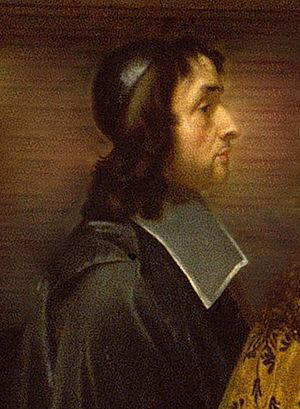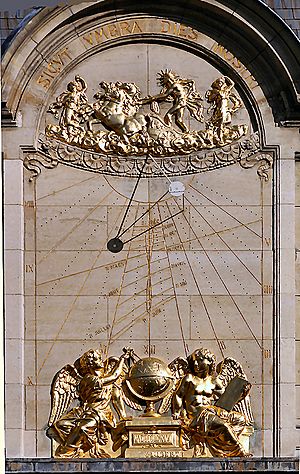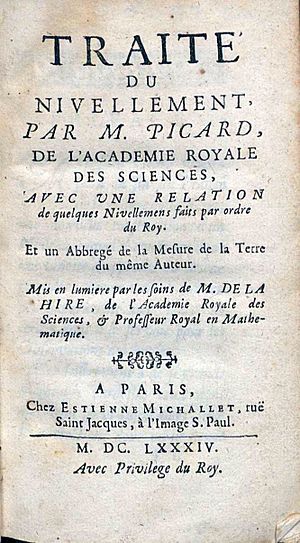Jean Picard facts for kids
Quick facts for kids
Jean Picard
|
|
|---|---|
 |
|
| Born | 21 July 1620 |
| Died | 12 July 1682 (aged 61) |
| Nationality | French |
| Occupation | Astronomer |
|
Notable work
|
Mesure de la Terre |
Jean Picard (born July 21, 1620 – died July 12, 1682) was a French astronomer and priest. He was born in La Flèche, France, and studied at a Jesuit school there. Picard is most famous for accurately measuring the size of the Earth. His work was a big step forward in understanding our planet.
Contents
Measuring the Earth's Size
Picard was the first person to measure the size of the Earth very accurately. He did this between 1669 and 1670 using a special method. He measured one degree of latitude (a part of the Earth's curved surface) along the Paris Meridian. This is a line running north-south through Paris.
To do this, he used a method called triangulation. He set up 13 triangles stretching from Paris to a clocktower near Amiens. By carefully measuring the angles and distances of these triangles, he could figure out the length of one degree of latitude.
His measurements showed that one degree of latitude was about 110.46 kilometers (68.64 miles) long. This meant the Earth's radius (the distance from the center to the surface) was about 6328.9 kilometers (3932.6 miles). Later, Isaac Newton used this exact number in his famous theory of universal gravitation.
Today, we know the Earth's polar radius is about 6357 kilometers (3950 miles). Picard's measurement was incredibly close, with an error of less than half a percent! This showed how much astronomy and its tools were helping to improve cartography (map-making).
Cool Tools for Stargazing
Picard made some important improvements to the tools astronomers used. He was the first to put a telescope with crosshairs (tiny wires that help you aim) onto a quadrant. A quadrant is a tool used to measure angles in the sky.
He also was one of the first to use a micrometer screw on his instruments. This tiny screw allowed for very precise adjustments. The quadrant he used to measure the Earth was large, about 38 inches (96 cm) in radius. It could measure angles down to a quarter of a minute.
His sextant, used for finding the meridian, was even bigger at six feet (1.8 meters) in radius. It also had a micrometer for fine-tuning. These better tools meant his measurements were much more accurate. His margin of error was only ten seconds, compared to Tycho Brahe's four minutes. This made Picard's work 24 times more accurate!
Other Amazing Discoveries
In 1670 and 1671, Picard traveled to Denmark. He visited Uraniborg, the old observatory of Tycho Brahe. Picard wanted to accurately measure its longitude (its east-west position). This would help scientists compare Tycho's past observations with new ones.
Picard worked with many other famous scientists. These included Isaac Newton, Christiaan Huygens, and Ole Rømer. He even worked with his main rival, Giovanni Cassini. These collaborations led to Picard's discoveries in other areas of science.
For example, he noticed something strange about light while at Uraniborg. He also discovered that mercury could glow faintly in a barometer. This glowing is called mercurial phosphorescence. This discovery later led to Newton's studies of light's visible spectrum.
Picard also created a standard way to measure the right ascension of a celestial object. Right ascension is like longitude for objects in the sky. In this method, an observer records the exact time an object crosses their meridian (an imaginary line in the sky). Picard used a very accurate pendulum clock for these observations. This clock had recently been developed by the Dutch physicist Christiaan Huygens.
His Lasting Impact
- His book "Mesure de la Terre" (Measurement of the Earth) was published in 1671.
- There is a lunar crater (a crater on the Moon) named after Picard. It is located on the southwest part of Mare Crisium.
- The PICARD mission, which is an orbiting solar observatory (a satellite that studies the Sun), is also named after him.
His Books
See also
 In Spanish: Jean Picard para niños
In Spanish: Jean Picard para niños
- List of Roman Catholic scientist-clerics
- Meridian arc
- Seconds pendulum



